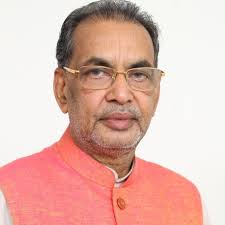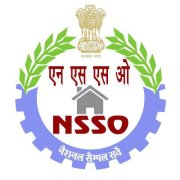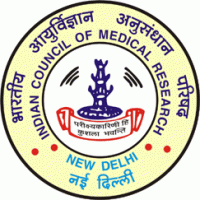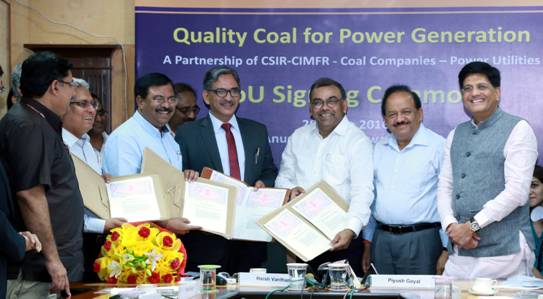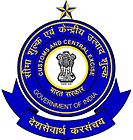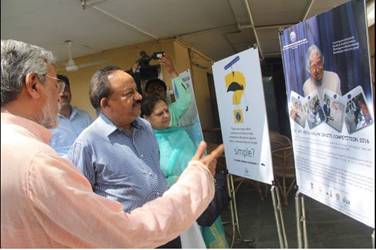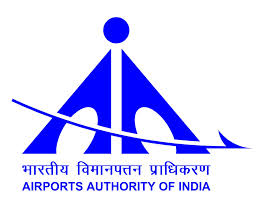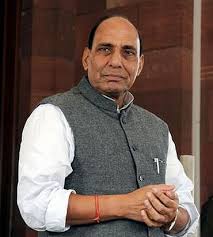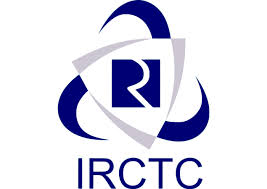The Union Minister for Agriculture and Farmers Welfare, Shri Radha Mohan Singh presenting the National Statistics Award, at the celebrations of the 10th National Statistics Day 2016, on the theme ‘Agriculture and Farmers Welfare’, in New Delhi. The Minister of State for Statistics and Programme Implementation (I/C) and External Affairs, General (Retd.) V.K. Singh is also seen.
Radha Mohan Singh presents National Statistics Award
National Sample Survey report on Household Spend on Services & Durables
The National Sample Survey Office (NSSO), Ministry of Statistics and Programme Implementation has released the report titled “ Key Indicators of Household Expenditure on Services and Durable Goods”based on the related information collected during July, 2014 to June 2015 as part of NSS 72nd Round. This survey on household expenditure on services and durable goods was the first focused survey of its kind undertaken by National Sample Survey Office.
The survey was designed to collect some demographic particulars, detailed information on household expenditure on transport, miscellaneous consumer services, food expenditures incurred in hotel & restaurants, expenditure on repair & maintenance services availed, hotel lodging charges, and on durable goods other than those used exclusively for entrepreneurial activity in India through a nationwide household survey.
As household expenditure on services forms an important part of Private Final Consumption Expenditure (PFCE), this focused survey is expected to provide improved estimates of household expenditure on the services as compared to the same based on data collected through usual Consumer Expenditure Survey. Also, in this survey, an attempt has been made to apportion the expenditure by the households on durable goods, when the durables are used both for household consumptions and enterprises.
The survey covered the whole of the Indian Union. The results of the survey are based on the sample, canvassed by NSSO, consisting of 7,969 villages and 6,048 urban blocks, spread over all States and Union Territories of the country. The schedule was canvassed in 47,535 households in rural areas and 36,065 households in urban areas during the period July, 2014 –June, 2015.
Some key findings on various aspects of Household Expenditure on Services and Durable Goods in the country as obtained from the survey during July, 2014 –June, 2015 are as follows:
- Transport Services
- Bus / Tram is the most reported means of transport both in rural and urban areas. About 66% households in rural areas and 62% households in urban areas reported expenditure on this particular mode. The next most reported means of transport was Auto Rickshaw (about 38% rural households and about 47% urban households). Taxi, Railways and Rickshaw are the other major modes of transport both in rural and urban areas as reported by the households.
- Expenditures on Bus / Tram, Auto Rickshaw, Taxi and Train account for more than 90% of the total expenditure on Transport both in rural and urban areas. Expenditure share of railways as mode of transport contributes much higher proportion in urban areas (12.54%) than that in rural areas (4.41%).
- Among different modes of transport, monthly per capita expenditure (MPCE) on Bus/Tram is highest both in rural (₹ 43.43) and urban (₹ 94.89) India.
- Miscellaneous Consumer Services
- Under this miscellaneous group, 14 broad services were considered. These included domestic services, barber & beauty shops, TV & radio services, laundry, dry cleaning, etc., repair & maintenance, communication, religious services, recreational & cultural services, funeral/burial/cremation-related services, business services, services incidental to transport, tailoring services and sewage disposal & sanitation, other services not elsewhere covered.
- In both rural and urban areas, about 90% or more households reported expenditure on barber & beauty shops and communication services. In case of budget-share of different types of miscellaneous services in rural areas, communication services accounted for the highest share (25.33%) followed by barber & beauty shops (11.07%), TV & radio services (10.58%), repair & maintenance (10.27%) & tailoring services (10.18%). In urban areas, communication services again accounted for highest share of budget (26.33%) followed by domestic services (12.11 %), TV & radio services (10.22%) and recreational & cultural services (9.95%).
- In terms of monthly per capita expenditure (MPCE) also, highest expenditure was found on communication services amounting to ₹ 36.35 and ₹ 102.46 in rural and urban areas respectively.
III.Other Services
- Certain other services like repairs and maintenance of some selected items, Annual Maintenance Contract (AMC), hotel lodging and other selected services, which are not covered in the earlier section are considered here under the broad head “repair & maintenance of selected items, hotel lodging charges, etc ”. All food expenditures in hotels and restaurants were considered under the broad head “food expenditure in hotels ”
- In terms of monthly per capita expenditure (MPCE), expenditure on “repair & maintenance of selected items, hotel lodging charges, etc.” was ₹ 55.77 and ₹ 88.28 in rural and urban areas respectively. On the other hand, the expenditure on “food expenditure in hotels” was ₹ 68.48 and ₹178.00 in rural and urban areas respectively.
- Durable goods
- The durable goods were grouped into 13 major broad groups, namely, transport equipment, heating, cooling and electricity generation devices, kitchen equipment, equipment for recreation, crockery and utensils, furniture and fixtures, other machines for household work, IT and communication devices, electrical and lighting accessories, productive equipment, sports and medical equipment, miscellaneous durables and jewellery and ornaments.
- The pattern of expenditure on different durable goods and their overall contribution in absolute terms, separately for those purchased for mainly using it for enterprise purpose and domestic purpose in the households having Non-agricultural Enterprise (NAE) was studied.
- In rural area, the share of budget spent on a particular durable group with reference to total expenditure on durables is highest for transport equipment (about 83%), when the purchase was done mainly for using it for enterprise purpose. The expenditure on each durable group of i) heating, cooling and electricity generation devices ii) IT & communication devices and iii) productive equipment separately accounted for about 4% of budget share. All other durable groups, except furniture & fixtures (1.6%) accounted for very little expenditure (each less than 1% in budget share). When the main purpose of use was for domestic purpose, though the highest budget share was in respect of transport equipment (about 45%), a notably high budget share of about 23% was observed on jewellery and ornaments followed by heating, cooling and electricity generation devices and IT and communication devices (both having a share of about 7% each), and furniture and fixtures (about 5.6%).
- In the urban area, almost similar pattern was observed except the fact that a high share of budget, next to transport equipment, was found for heating, cooling and electricity generation devices (about 7.9%) and for IT and communication devices (7.8%) when the main purpose was for enterprise. When the main purpose was for domestic use, high share of budget, next to transport equipment, was on jewellery and ornaments (18%) followed by IT & Communication (9.9%) and heating, cooling and electricity generation devices (8.1%).
- In terms of absolute values of monthly per capita expenditure (MPCE) on all durable goods by the households having Non Agricultural Enterprise (NAE), a total expenditure of ₹ 436.85 and ₹1468.69 were observed for the main purpose of enterprise and domestic use respectively in rural areas. In urban areas, these values were ₹ 379.63 and ₹ 2601.54 respectively.
The publication based on above cited Key Indicators is available on the website (www.mospi.gov.in) of the Ministry of Statistics and Programme Implementation.
‘Solar for Healthcare’ Initiative launched by ICMR-CEEW
The Indian Council of Medical Research (ICMR) has signed an MoU with the Council on Energy, Environment and Water (CEEW), a policy research institution, to launch a new ‘Initiative on Solar for Healthcare’. The collaboration will focus on providing effective health care delivery at the last mile by reducing uncertainty in critical infrastructure, particularly electricity supply via cost effective solar-based solutions.
Dr. Soumya Swaminathan, Director General, ICMR said: “The collaboration with CEEW will bring together synergies between the objective of ‘time to care’ as mandated in the National Health Mission (NHM) and clean energy as outlined under the National Solar Mission (NSM). Under this collaboration, on a pilot basis, we will install solar systems at select PHCs in partnership with three state governments and evaluate its impact on healthcare delivery and health outcomes. The aim of the collaboration is to create resilient health systems in rural India, benefitting primarily women and children.”
As of 2015, nearly 35 million citizens in rural India rely on un-electrified PHCs for primary health services. In the absence of electricity, services catered by health institutions such as institutional deliveries, paediatric emergencies, and administering of vaccines get severely affected. Electricity access in health centres is also imperative as a means to facilitate communication services, tele-health applications and to retain skilled health workers. Dr. Arunabha Ghosh, CEO, CEEW, said, “The collaboration with ICMR supports the systematic and productive advancement in national policies, regulations and actions to leverage solar energy for a social purpose: enhancing the quality of healthcare delivery at various levels of governance.”
The synergy between health and energy are the two specific goals of this initiative, and the efforts within this collaboration advances on both fronts.
Canadian forests a refuge as warming creeps north
Summary:Boreal forests in far-northern latitudes may one day act as a climate refuge for black spruce, the foundational tree for the northwoods ecosystem — a major source of the world’s paper; home to caribou, snowshoe hare, lynx, and sable; and nesting site for dozens of migratory bird species, say researchers.
In the Canadian province of Quebec, a study of more than 26,000 trees across an area the size of Spain forecasts potential winners and losers in a changing climate.
The study, published today in the journal Science, shows that boreal forests in far-northern latitudes may one day act as a climate refuge for black spruce, the foundational tree for the northwoods ecosystem — a major source of the world’s paper; home to caribou, snowshoe hare, lynx, and sable; and nesting site for dozens of migratory bird species.
“During this century, the northwoods will experience some of Earth’s largest increases in temperature,” says Loïc D’Orangeville, postdoctoral researcher at Université du Québec à Montréal and Indiana University, who led the collaboration of scientists from six institutions in the U.S. and Canada.
Northern boreal forests are a crucial part of the global climate puzzle, comprising nearly 30 percent of Earth’s forested area and storing at least 20 percent of its carbon. The study’s tree ring analysis revealed these forests’ sensitivity to changes in temperature and precipitation.
“A warming climate increases the amount of water boreal forests need to survive,” explains D’Orangeville. “It’s possible that only a relatively small part of North America’s boreal forest will have enough water to compensate for the increased demand.”
North of a certain latitude (broadly 49 degrees North), the study showed, warming melts snow earlier and lengthens the growing season: good news for tree growth. “Right now — June and July — is when most of the annual tree growth takes place in the boreal forest,” says D’Orangeville. Climate models predict that by 2050, the growing season in the study area will have expanded by 3 weeks.
South of the 49th parallel, however, warming and the lengthened growing season are more likely to cause drought stress that could overwhelm black spruce. The researchers say this may explain increased tree mortality already being observed in the region.
“But as you move northwards, temperatures cool, and evaporation diminishes,” says D’Orangeville. As climate warms through 2070, more than two-thirds of the forested territory just above the 49th parallel should still be showing a positive response.
“This part of the forest could adapt to climate change in our lifetime, if future warming stays below the temperature threshold,” says Neil Pederson, co-author of the study and a senior ecologist at Harvard Forest. “But the future cannot be perfectly predicted.” And, he cautions, unpredictable factors, such as the recent mega-fires in boreal regions of western Canada and Alaska, could disrupt this dynamic.
Still, the study offers a note of hope. “In a world where many ecological forecasts appear dire for plants, animals, and people,” says Pederson, “identifying areas that could serve as potential havens for biodiversity during potentially tumultuous times is good news.”
Source:Harvard University(science)
CSIR-CIMFR Dhanbad to analyse quality of coal for power generation
CSIR-CIMFR, a constituent laboratory of Council of Scientific & Industrial Research (CSIR), entered into an MoU with Coal Supplying Companies and Power Utilities for the quality analysis of coal being supplied to power utilities by the coal supplying companies. This collaboration will enhance efficiency of use of coal by the power sector. Union Minister for Science & Technology and Earth Sciences, Dr. Harsh Vardhan presided over the agreement signing ceremony along with Shri Piyush Goyal, Union Minister of State (IC) for Power, Coal, New & Renewable Energy.
Dr. Harsh Vardhan, while praising the efforts of CSIR, said that the Government of India, under the guidance of the Prime Minister, is guided by the ethos of transparency, quality control and a corruption-free environment. Hence, this culture will be carried forward through the research at CSIR laboratories in the field thermal energy generation as well and this agreement is the first step in this direction.
Shri Piyush Goyal emphasized on the point that India is the third largest consumer of coal globally, after China and the US, and the share of coal in its energy mix has been rising. Thermal coal accounts for around 85% of India’s coal consumption and the power sector accounts for more than 70% of India’s coal use. Moreover, high ash and moderate moisture content of Indian coal and the use of sub-critical technologies by over 90% of India’s coal-fired fleet reduces the efficiency of its power plants to a great extent.
The mandated use of super-critical technology by the upcoming coal-fired projects in India makes it necessary for the plants to run on high energy, low ash coal. In such a scenario the signing of today’s agreement assumes a lot of importance. The Minister noted that the pilot study has been going on since January this year and now a 10-year contract is being signed for future scaling up of the process.
As a part of this MoU, CSIR-CIMFR would make use of its knowledge base support in maintaining the quality of coal at national level for the entire power sector. It is estimated that about 300 million metric tons of coal samples would be analyzed for quality per year. The contract value of the project is around Rs. 250 crores per annum.
The efforts through the aforesaid project would minimize the disagreements on quality issues between coal producers and end users. The endeavor would help the nation in sustainable energy supply and security planning for future as it may reduce import of thermal coal.
CSIR-CIMFR is providing knowledge based support to the entire coal based energy chain encompassing exploration, mining and impact on the environment. Further, the laboratory is engaged in surveys of other mineral deposits and excavation for hydro-electric projects, tunnels and railways. It plays pivotal role in establishing the national coal inventory and is involved in maintaining the consistency of coal quality for power and other sectors leading to energy security and growth with high standards of safety, productivity and cleaner environment.
Other dignitaries present at the event were Dr. Girish Sahni, DG, CSIR and Secretary, DSIR, Shri Anil Swarup, Secretary, Ministry of Coal Shri Pradeep Kumar Pujari, Secretary, Ministry of Power.
Indian Taxpayers Survey
The Central Board of Excise & Customs (CBEC) had requested FICCI to conduct a tax payers’ experience survey with the objective of garnering a feedback on impact that reforms undertaken during the last two years had on the ground. FICCI outsourced the survey to KPMG and they jointly reached out to 40000-45000 potential respondents across India. The survey was accompanied with a flier detailing the reforms carried out by the CBEC in the last two years (attached).
The key question of the survey was – “Do you feel a perceptible change in policies of the CBEC by way of becoming liberal and friendly to the taxpayer?” An overwhelming number of respondents, 72%, responded with a “yes” The fact that a tax department had the gumption to ask such a question and the taxpayers having actually acknowledged positively, both are a harbinger of increasing maturity of the regulatory ecosystem of India.
The questionnaire centred upon four themes –
- Interaction experience with senior and junior functionaries of the department
- Dispute resolution
- Information Technology Enabled Services
- Refund claims
- Evaluation of sectoral reforms undertaken by the CBEC.
As business demographics would suggest, respondents from Maharashtra outnumbered all states, with respondents making up for 30%, Delhi followed at number 2, with 11%. Sectoral responses showed that 46% respondents from service industry, 39% from manufacturing and 15% from the trading community. This trend reveals the importance that service tax has acquired over the years, broadening the tax payer base and accounting for Rs. 2, 11,456 crore which is 26% of the Indirect Tax revenue.
The responses showed that 45% of the respondents saw an attitudinal change in senior functionaries (Commissioner level and above); and 51% acknowledged an improvement at the ground level, at the level of inspectors and above. This should come as heartening news for India Inc, as it is the inspector raj which is considered as the most stubborn stumbling block to improving the tax environment. In wake of widespread allegations of tax terrorism, which has most often been cited as a barrier to entry of foreign investment in manufacturing, the survey sought an opinion on whether the CBEC administration was becoming less adversarial. 32% of the respondents answered in the affirmative, which is indicative of an improving trend but does show that much needs to be done. The most outstanding achievement of the CBEC was getting the customs single window project off-the-block on 1st April 2016. Interestingly, USA had also launched its single window in the same period but had to eventually stagger dates for accommodating different government agencies and had to infact drop FDA altogether for the time being. In India’s case the project was a top most priority with the PMO and Cabinet Secretary, which brought together 6 ministries on a single window. CBEC’s team evolved a unique methodology to solve teething problems by creating a whatsapp group for continuously receiving a feedback on operational issues faced by the trade and disseminating solutions. At the ports, customs brokers made their own whatsapp groups to share experiences and information. The implementation of the project has shown the power of the digital applications in problem solving and CBEC’s adaptability in being able to successfully leverage it. In a short span of time, the single window has had a huge impact on custom clearance processes. The survey saw respondents acknowledge the improvement. 76% respondents found improvement in customs clearance process. For a highly IT driven department, it was also very heartening to note that 75% of the respondents were satisfied by the IT enabled services.
Responses on sectoral reforms also generally received a thumbs up, including refunds. 49% of respondents acknowledged a positive change in processing of refunds. Of most interest to foreign businesses were responses to reforms undertaken in SVB (transfer pricing in customs) where 89% of the respondents indicated improvements. Similarly, responses on legislative changes carried out to warehousing in the budget also elicited a positive response from 85% of the respondents. Considering the make in India initiative, central excise has been a major area of focus. 92% of the respondents have acknowledged CBEC’s success in simplification of customs & excise business processes.
After this poll, FICCI & KPMG have also given to the CBEC a wish list of respondents. The 10 MUST Dos are:
- Infuse attitudinal changes
- Focus on Tax evaders
- Simplify Procedures
- Fast track adjudication
- Reduce litigation
- Expedite refunds
- Introduce e-communication
- Improve website and IT Platform
- Enhance training
- Improve Office infrastructure
Government stands solidly behind Grassroots Innovators- Dr. Harsh Vardhan
Union Minister of Science & Technology and Earth Sciences, Dr. Harsh Vardhan, visited National Innovation Foundation-India (NIF), Ahmedabad. He interacted with the staff members and witnessed an exhibition on grassroots innovation.
While addressing the press, Dr. Harsh Vardhan underlined the extraordinary commitment the present government has made to ensure that no worthy innovative idea remains unsupported. National Innovation Foundation is taking this determination of the government forward by providing hand holding support to grassroots innovators and tens of thousands of school children.
The Minister particularly appreciated the extremely affordable solutions being developed by the NIF based on the ideas of knowledge-rich, economically-poor people. He personally tested the adjustable-leg walker on stairs designed to help elderly and others needing assistance based on the idea of a school girl.
Dr. Harsh Vardhan noted the fact that NIF has mobilized, with the help of volunteers of honey bee network, more than 200,000 ideas from 585 districts of the country. He envisioned that these be categorized, prioritized and then taken up for fast track value addition.
Appreciating the platform like Techpedia, which can be used to link a lot of unmet social needs and grassroots ideas with technology students, the Minister said that he is convinced that the present mood of the country to give push to the start-up movement in India will get a further boost through the Micro Venture Innovation Fund (MVIF), community workshops and fablab set up by NIF. He exhorted the youth as well as those in the informal sector to come forward to avail the friendly and flexible support provided by NIF to ITI students, school children and creative people of the informal sector.
Boeing launches 2nd Century Aerospace Leadership at Farnborough Airshow
Boeing will celebrate its 100th anniversary at the Farnborough International Airshow, displaying advanced commercial and defense platforms, and presenting a unique exhibit to commemorate its first century and look ahead to the future.
The first jetliner of Boeing’s second century—the 737 MAX—will make its air show debut with flying displays from July 11-14. Boeing expects to deliver the first 737 MAX 8 in the first half of 2017, ahead of schedule.
A 787-9 Dreamliner to be delivered to ANA, Japan’s largest airline, will also participate in the flying display from July 11-13. The airplane will be the first ever in a Japanese airline livery to participate at the Farnborough Airshow.
Other Boeing commercial airplanes on display include a new Volga-Dnepr 747-8 Freighter, which will be at the show from July 11-13.
The multi-mission P-8A, a military derivative of the Next-Generation 737-800 that provides advanced anti-submarine and anti-surface warfare capabilities, will join Boeing’s multi-role F/A-18F Super Hornet fighter in demonstrating versatile capabilities during daily flying displays. The P-8A aircraft also will be on static display along with an F/A-18E Super Hornet and an F-15E Strike Eagle.
Boeing is marking 100 years of innovation with a special pavilion that will be open throughout the show. In addition to interactive displays showcasing the company’s past, present and future technologies, the Boeing Centennial Experience will also feature kiosks with access to the digital archive of every issue of “Aviation Week & Space Technology”, which is also celebrating its 100th year. The pavilion (OE5) will be located opposite the Boeing main chalet (B 1-6), across Bofors Hill, next to Hall 2.
An app called Boeing Innovations, intended for guests to use during their visit to the pavilion, will be available for download in July through iTunes and Google Play.
As part of its first century celebration, Boeing is sponsoring “Above and Beyond,” a new interactive exhibition about the wonders of flight and humankind’s remarkable journey to space. This family-friendly exhibition, created in collaboration with NASA, is intended to inspire the next wave of engineers, pilots and astronauts. “Above and Beyond” will be open to the public at the National Maritime Museum in Greenwich until August 29 (www.rmg.co.uk/see-do/
In addition, aviation enthusiasts will have the opportunity to purchase exclusive products featuring Boeing Centennial designs, heritage collection and aircraft models from the merchandise trailer area and Gate B merchandise tent locations at the show.
Historic Boeing airplanes will also appear during the public week-end on flying or static display, including a P-51D Mustang, a B-17 Flying Fortress, a DC-3 Dakota and a B-25 Mitchell, among others.
Together with the Royal Aeronautical Society, Boeing will present RANS Coyote II airplanes built by students from the “Schools Build a Plane Challenge” – a STEM initiative targeted at young people in UK secondary schools:www.boeing.co.uk/sbap. One of the light aircraft, constructed by pupils from Ercall Wood Technology College in Telford, will participate in the flying display on July 15. Another aircraft, which is in mid-construction at North East Wolverhampton Academy will also feature in the static display.
Boeing will hold a series of briefings for news media during the show, as listed below. Media attending the show should check the briefing schedule daily for updates at the Boeing-sponsored Media Centre and the Boeing media chalet in row B 1-6.
Follow @BoeingAirplanes, @BoeingDefense, @Boeing and @BoeingUK on Twitter and Boeing on Instagram, or online atwww.youtube.com/user/Boeing and www.boeing.com for news and features from the show.
News media should visit http://boeing.mediaroom.com for schedule updates on briefings and events as well as for news releases and background information. News media may also subscribe to Boeing updates via text message. Text the keyword BOEING, followed by your name and media affiliation, to +44 7800 002 490.
Note: All times listed below are local to Farnborough.
Monday, July 11 – Thursday, July 14
The 737 MAX will be available for tours to accredited members of the news media:
- Monday, July 11 – 11.30-12.30
- Tuesday, July 12 – CLOSED
- Wednesday, July 13 –10.00-11.00 (with Global Eagle Entertainment Wi-Fi demonstration)
- Thursday, July 14 – 11.30-12.30
Monday, July 11
09.45 2016 Current Market Outlook – Radlett Suite, Media Centre Hall 1A
Boeing Commercial Airplanes Vice President of Marketing Randy Tinseth and Senior Vice President of Sales and Marketing John Wojick will reveal the new Current Market Outlook data and address current industry and commercial aviation market conditions.
12.00 V-22 Media Briefing with Joint Program Office– Hatfield Room, Media Centre Hall 1A
U.S. Marine Corps Col. Dan Robinson, V-22 Joint Program Office program manager, will brief V-22 operational capabilities and future advancements, to include CV-22, CMV-22, and MV-22.
Tuesday, July 12
10.30 Cargo Market Outlook Briefing – Volga-Dnepr Chalet, Cargo Village
Boeing Commercial Airplanes Vice President of Marketing Randy Tinseth will provide an overview of Boeing’s assessment of the current air cargo market.
11.00 P-8 Media Briefing with U.S. Navy – Hatfield Room, Media Centre Hall 1A
U.S. Navy Capt. Tony Rossi, program manager for the Maritime Patrol & Reconnaissance Aircraft program office, and Steve Tripp, Boeing Global Sales & Marketing, will provide an update on the P-8 program.
12.00 Commercial Airplane Development Briefing– Boeing Media Chalet Theatre
Boeing Commercial Airplanes Vice President and General Manager of Airplane Development Mike Delaney provides update on the company’s newest commercial jetliners currently in development – 737 MAX, 787-10 Dreamliner and 777X.
Friday, July 16
09.30 Futures Day Lectures for students – Boeing Media Chalet
Richard Pillans, Boeing Chief Test Pilot and former British Army Helicopter Pilot and Flight Commander, will give a talk about his experiences as the head of the team of pilots and engineers who oversee all Boeing Military Aircraft flight operations for Boeing Defence UK, including the Royal Air Force’s fleet of Chinook helicopters. Second session to be held at 10.20; third session at 11.15.
Boeing is the world’s largest aerospace company and leading manufacturer of commercial jetliners and defense, space and security systems. As America’s biggest manufacturing exporter, the company supports airlines and U.S. and allied government customers in more than 150 countries. Boeing products and tailored services include commercial and military aircraft, satellites, weapons, electronic and defense systems, launch systems, advanced information and communication systems, and performance-based logistics and training.
Headquartered in Chicago, Boeing employs approximately 160,000 people across the United States and in more than 65 countries. Our enterprise also leverages the talents of hundreds of thousands more skilled people working for Boeing suppliers worldwide. Total company revenues for 2015 were $96 billion.
Bandaru Dattatreya meets the Union Home Minister
The Minister of State for Labour and Employment (Independent Charge), Shri Bandaru Dattatreya meeting the Union Home Minister, Shri Rajnath Singh, in New Delhi.
Free Registration for e-wallet extended by IRCTC for a week
Spurred by the success of its e-wallet that provides a cheaper, reliable and smoother payment option for e-ticketing at its portal, Indian Railway Catering and Tourism Corporation (IRCTC) has extended free registration for the facility by a week, beginning IRCTC had launched the e-wallet as an alternative payment system for e-ticketing on its website in 2012 as a pilot project. In May this year, it made free registration available for a month (16 th May –15 th June). From June 16 onwards, an amount of Rs 50 was being charged for “We have decided to extend free registration for IRCTC e-wallet by a week to encourage our patrons to adopt the facility that ensures an alternative and easy payment option for e-ticketing.
The success rate of booking tickets through IRCTC e-wallet has been more than 99 per cent,” said IRCTC Chairman and Managing Director (CMD) Dr A K Manocha. “There have been some complaints of money being deducted without tickets being booked, when payment is made through other Payment Gateways. We are determined to address this problem completely through IRCTC e-Wallet. We have already introduced several technical changes in e-wallet, including round the clock booking of e-tickets,” he pointed out.
During the free month-long registration period, the total number of registrations for e-wallet stood at 10,673 with an average of 344 registrations a day. During this period, e-ticket booking through the wallet was not allowed between 0800 hrs and to 1200 hrs. However, booking through the wallet during this period (0800 hrs to 1200 hrs) has now been permitted with effect Likewise, from June 16 onwards when Rs 50 is being charged for registration, there have been 2,988 registrations with an average of 272 registrations per day.
IRCTC’s e-wallet has several advantages as compared to other payment options on its website. It can be topped up in the multiple of Rs 100 up to a maximum of Rs 10,000. This payment instrument is cheaper and charges only Rs 5 per transaction.
Also, payment through the e-wallet is highly secured through a Two-Factor Authentication: transaction password and OTP on registered mobile at the time of payment. IRCTC’s e-wallet registration is at present available by verification through PAN card and will soon be available through Aadhar card also.
IndianBureaucracy.com wishes the very best.
RFID Based Access Control System Inaugurated at Cochin Port
Dr. K. N. Raghavan, Commissioner of Customs, Cochin inaugurated a RFID (Radio Frequency Identification System) newly installed at Ernakulam Wharf of Cochin Port. The RFID is an access control system on digital platform for regulating movement of vehicles, cargo and people into the sensitive wharf area. The system dispenses away with manual checkings and reduces the waiting time at the wharf gates.
Presently, access control of vehicles and persons are done through a manual gate pass system.
The Port Users have registered in the system and have been given RFID tags. These are pasted on the windshield glass and access is granted when the sensor of the system captures and recognizes the vehicle at the gates. The system works on ultra-high frequency signals and every entry and exit of all vehicles are stored in a system of computers, which enables long period of storage with easy retrieval facility of historical data at any point of time.
The introduction of RFID is one of the key steps in the modernization plan of India’s seaports, formulated by the Government of India, for Port Sector security and efficiency enhancement.
IndianBureaucracy.com wishes the very best and congrats on being proactive.


